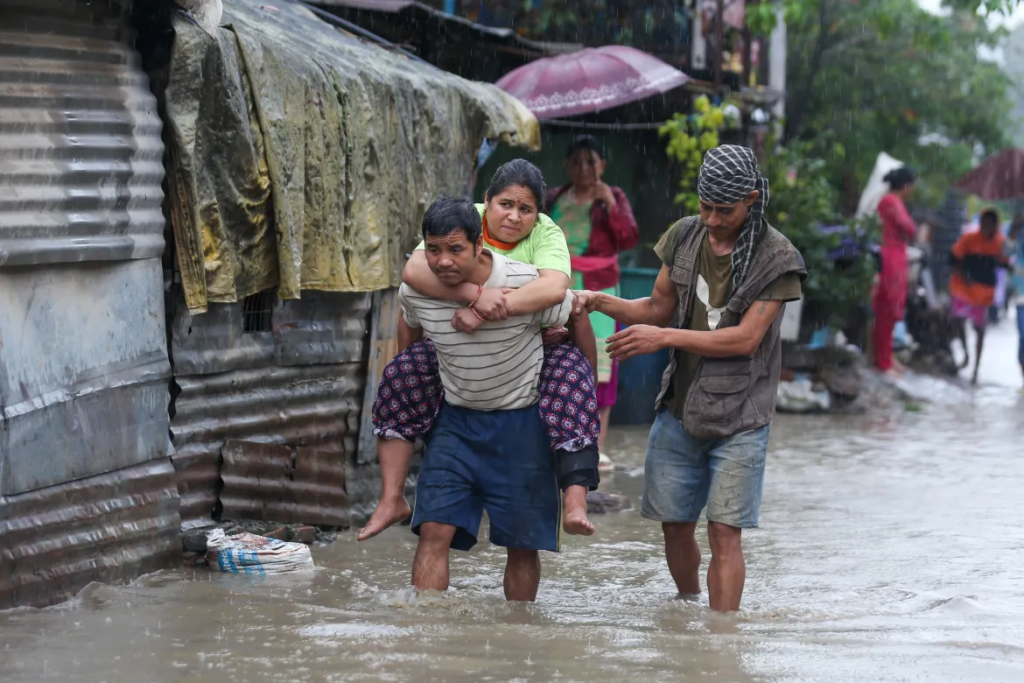The Himalayan Heartbreak: Combating Nepal’s Annual Monsoonal Onslaught
Nepal, the crown jewel nestled amidst the Himalayas, faces a yearly ordeal during the monsoon season: devastating floods and landslides. These ferocious natural disasters wreak havoc on the country’s delicate ecosystem, tragically claiming lives, displacing entire communities, and leaving a trail of widespread destruction in their wake. We will delve into the root causes and far-reaching consequences of these events, underlining the urgent need for proactive measures to lessen their devastating impact.

A Precarious Perch
Nepal’s geographical makeup plays a critical role in its susceptibility to these disasters. The youthful and geologically active Himalayas are particularly prone to erosion, resulting in loose soil highly vulnerable to landslides. The steep slopes further accelerate these events, especially during periods of heavy rainfall. The annual monsoon season brings relentless downpours, saturating the ground and triggering catastrophic landslides. Deforestation exacerbates this issue as trees, which act as natural anchors, are removed, further destabilizing the slopes. Additionally, infrastructure projects with good intentions, like road construction, can inadvertently disrupt the fragile mountain ecosystems, inadvertently increasing landslide risks.
A Deluge of Destruction
Floods are another unwelcome consequence of the monsoons. The overflowing rivers, unable to contain the surge of water, breach their banks, inundating low-lying areas and turning fertile agricultural land into vast, churning waterways. Flash floods, caused by sudden cloudbursts or glacial lake outbursts, are particularly devastating. These sudden surges of water leave little to no time for escape, often resulting in a heartbreaking loss of life. The repercussions of floods and landslides extend far beyond the immediate casualties. Damaged infrastructure disrupts vital communication and transportation networks, hindering rescue efforts and jeopardizing access to essential services. Displaced communities lose not only their homes but also their livelihoods, facing immense hardship as they seek refuge in temporary shelters. The destruction of crops poses a severe threat to food security, further exacerbating the already dire situation.
Beyond the Immediate Crisis: A Ripple Effect
The impact of these disasters extends far beyond the immediate crisis. Damaged roads and bridges significantly hinder economic activity, impacting trade and tourism – two vital sectors for Nepal’s development. Additionally, stagnant floodwaters create breeding grounds for waterborne diseases, posing a serious health risk, especially for vulnerable populations like children and the elderly. The psychological trauma caused by witnessing loved ones lost or homes destroyed can have long-lasting effects, leaving deep emotional scars on survivors.
Breaking the Cycle of Devastation: A Multi-Faceted Approach
Mitigating the impact of floods and landslides requires a multifaceted approach. Long-term strategies like promoting large-scale afforestation initiatives and adopting sustainable land management practices are crucial to stabilize slopes and reduce the frequency and severity of landslides. Early warning systems, coupled with comprehensive public education and community preparedness programs, can equip people to identify warning signs and evacuate endangered areas before disaster strikes. Investing in disaster-resistant infrastructure like sturdier buildings and elevated roads can significantly minimize damage.
A Global Responsibility: Standing with Nepal
Nepal cannot effectively address this challenge alone. Developed nations have a critical role to play by providing technical expertise and financial assistance. This support can be directed towards implementing preventative measures and strengthening disaster response mechanisms. Collaboration on research aimed at better understanding and predicting landslides is crucial for developing more effective mitigation strategies.
A Call to Action: Building Resilience for a Brighter Future
Floods and landslides are not inevitable. By prioritizing proactive measures, fostering international cooperation, and building resilience, Nepal can significantly reduce the devastation caused by these natural disasters. The lives and livelihoods of countless Nepalese depend on this collective effort. Only when its people are safe and secure can the breathtaking beauty of Nepal be truly admired.




















